Cash registers are so readily available and are used in many stores around the world that it is quite difficult to imagine that there are certain registers that would sell for over $10,000.
Many people are unaware of the value of the antique cash register in their garage or the ‘junk’ taking up space in their store. This article discusses how to identify and determine the value of that “old and obsolete” cash register that you intend to dispose of.
Table of Contents
What Are Cash Registers and How Did They Come to Be?
A cash register is a machine that allows you to store money while also keeping track of daily transactions and sales data. It is typically used in retail locations and has a cash drawer. It also displays and records every sale.
Now that you know what a cash register is, did you know that they weren’t always the way they are today?
Jacob James Ritty invented the first cash register in 1879. Ritty was a saloonkeeper in Dayton, Ohio, at the time, and he observed that his bartenders frequently stole from him.
When he realized this issue, he made up his mind to fix it. He then approached his mechanically inclined brother, John, and they began working on the machine.
After a few unsuccessful attempts, they devised a register that assisted in adding recent sales to the day’s sales and displayed the grand total.
There was no cash drawer on the register at the time of this invention, and it only had a few keys that depicted the currency that was used at the time (dollars and cents). On November 4, 1879, Ritty’s invention was patented as “Ritty’s Incorruptible Cashier.”
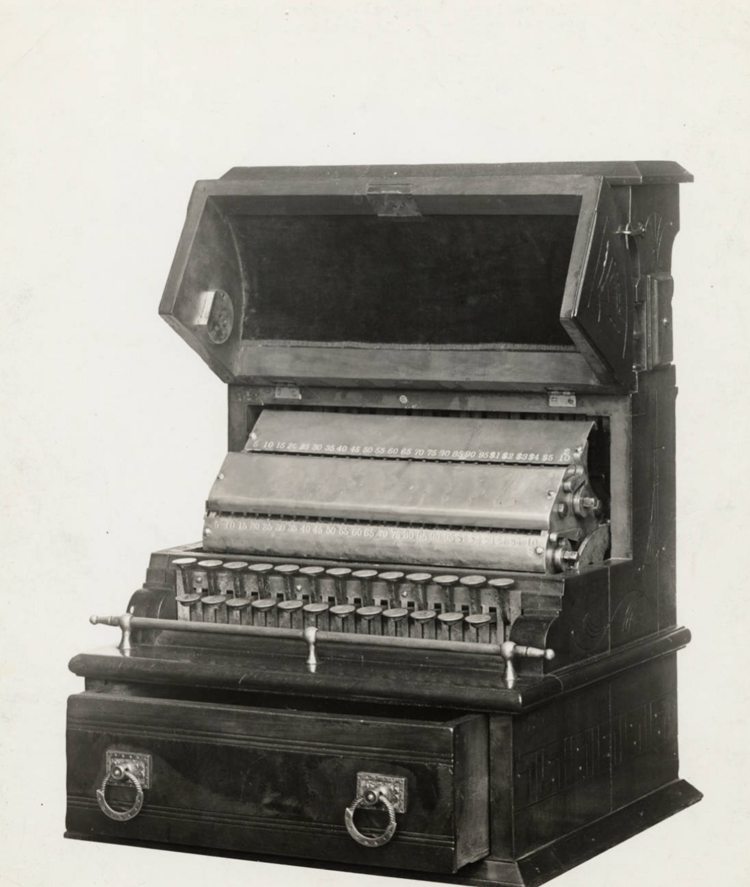
Following the completion of the cash register, the saloon owner and his brother decided to open a small factory in Dayton, Ohio to continue manufacturing their invention while still operating the saloon.
James quickly realized the enormous stress that comes with running two businesses, so he sold the patent rights to Jacob H. Eckhert. in order to avoid losing both.
Jacob H. Eckhert bought the patent rights from Ritty, and Eckhert founded the National Manufacturing Company to produce more registers.
In the design of the register, he also incorporated a cash drawer and a bell that would alert the shop’s owner when a sale was completed.
The National Cash Register Company
When John H. Patterson and his brother Frank learned about cash registers, they decided to invest in the National Manufacturing Company in 1883. By 1884, they held a majority stake in the company and decided to rename it the National Cash Register Company.
To keep the business from failing, John Patterson decided to try a new approach to marketing cash registers. He formed the American Selling Force, a sales team that focused on selling the features of the register rather than the machine itself.
Their efforts paid off, as they became the major cash register distributor of the beginning of the 20th century.
Only four of the 48 companies that sold cash registers between 1888 and 1895 survived the high competition. They include: National Cash Register, St. Louis, Ideal, and Michigan, with the National Cash Register Company having 95 percent of the market share in 1915.
The national cash register company didn’t rest on its past achievements. It kept coming up with new improvements, like printing a receipt for each customer and even introducing electric motors early in the 20th century.
The National Cash Register Company Today
Despite being the largest employer in Dayton, Ohio in the early 1900s, the national cash register company struggled to compete in the market after the world wars.
This was after the company made a successful entry into the computer market in 1957. The company was later renamed to the NCR corporation in 1974.
AT&T eventually completed a hostile takeover of the company in 1991, renaming it AT&T Global Information Solutions.
Three years later, AT&T decided to split into three companies, and the national cash register company fought for, and won, independence, before being renamed to its current name (NCR Corporation).
The company was completely restructured, with approximately 8500 jobs lost, and they exited the computer manufacturing business to focus on multiprocessing computers for commercial data warehousing.
Top Cash Register Manufacturers
Although the national cash register company was the most successful, there were a few other manufacturers at the time, such as Hallwood, St. Louis, Chicago, Michigan, Ideal, Boston, Remington, Lamson, and Sun, amongst others.
Easy Ways to Identify Antique Cash Registers
Now that you have a comprehensive understanding of cash registers, we will now focus on how to properly identify antique cash registers. You might be wondering if that cash register in your garage or the one you’re about to carelessly dispose of is an antique.
The features outlined below are simple methods for identifying your antique cash register.
The Weight and Appearance of the Cash Register
An antique cash register is typically heavier than a standard cash register and has circular keys and a stepped-key design, similar to a standard typewriter.
When you look at the back design of an antique cash register, you will notice that it is rectangular in shape, with unique designs on the back and sides.
Your cash register may even bear the logo of its manufacturer. So, if your cash register is heavy, resembles a standard typewriter, has a rectangular shape when viewed from the back, and is uniquely designed, it is likely an antique.
The Working Mechanism of the Cash Register
Unlike earlier models of the cash register, cash registers in the 21st century and especially in 2022 are automated, and many of them do not include a bell that alerts the shop owner whenever a sale is made.
Earlier models had many different working mechanics than the cash registers that were manufactured more recently.
It should also be noted that, in addition to the bell and receipts, there are a variety of other working designs, so even if your cash register has a very different mechanism than those described in this article, it may still be an antique cash register.
Other indications include you having to punch in every number, as opposed to the automated cash registers today where you can just select on a screen.
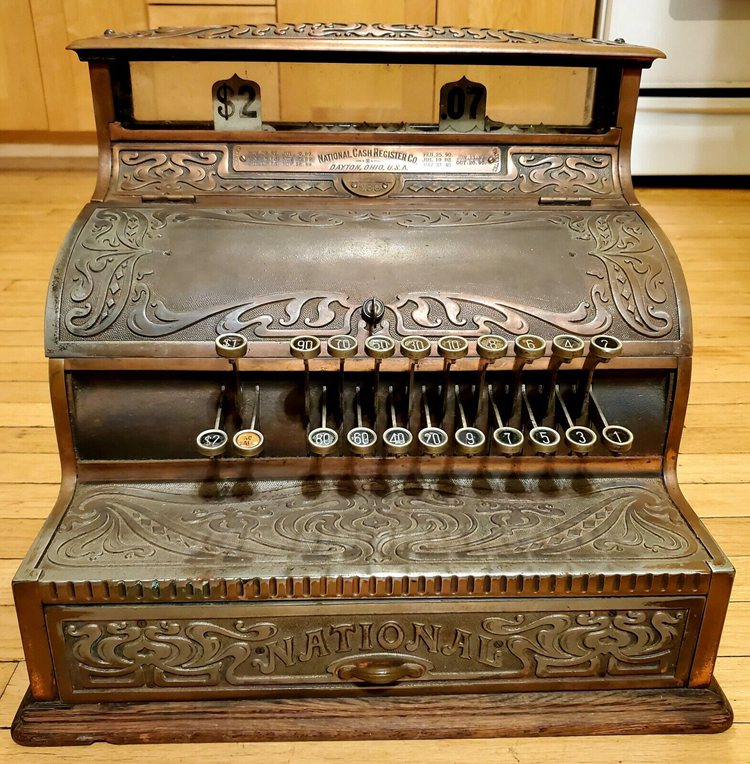
If you’re having trouble determining whether your cash register is an antique based on its functions or working mechanisms, you can seek assistance online, or visit the brand’s official website and ask for clarification.
The Exterior Design
The exterior design of an antique cash register is also a precursor to the register’s value. In other words, the type of exterior an antique register has is one of the main factors in how much it’s worth.
Early cash registers, particularly those made before 1915, had a lot of fancy designs, but the use of steel made it hard to decorate the exterior of cash registers as much as before.
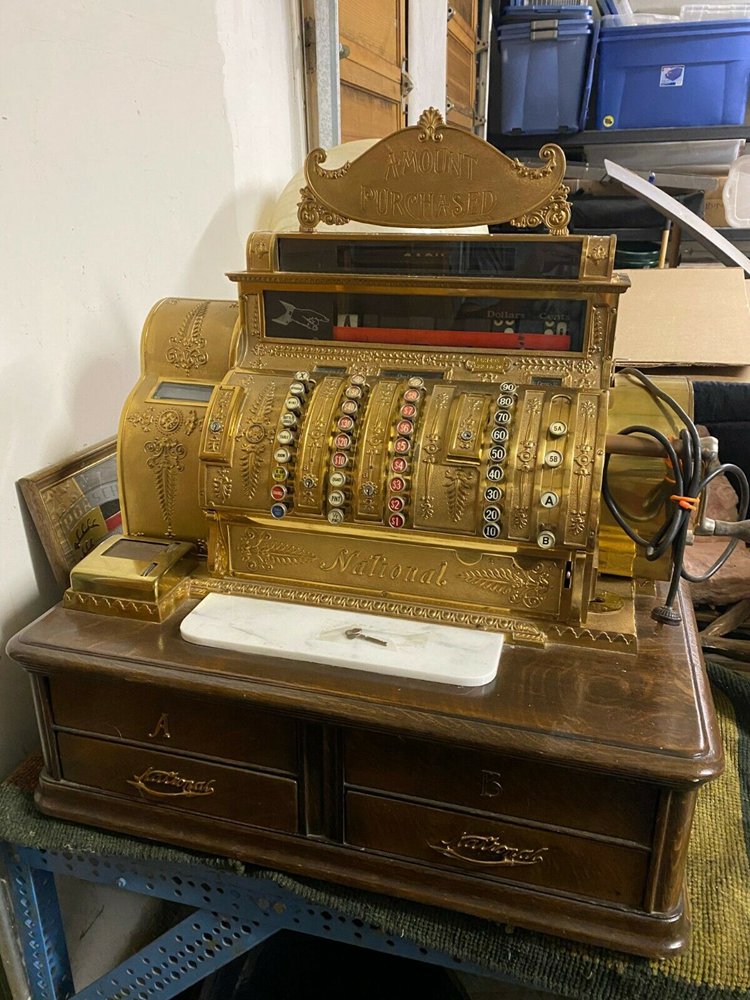
So, if you observe the exterior of the register you have or see, it might tell you something about how valuable it is.
The Interior Compartment
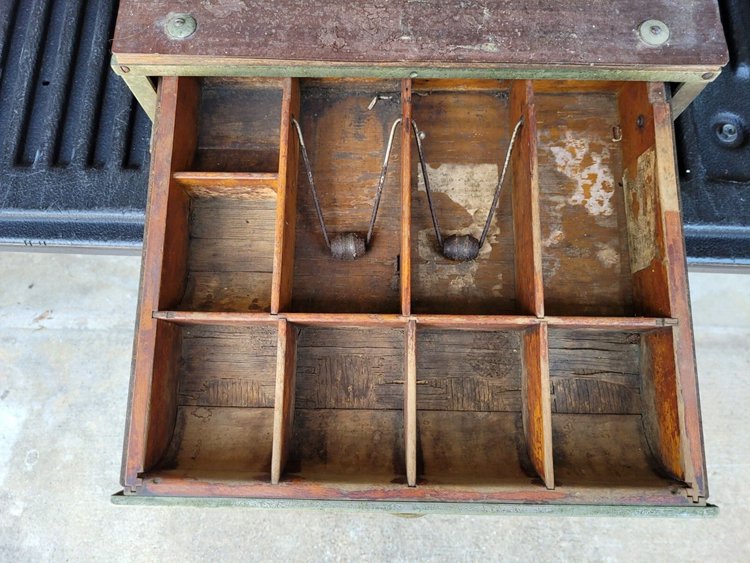
Although the interior compartments of cash registers can be used to determine whether or not they are antiques, this is not the best method.
This is largely because the designs of early cash registers had different interior compartments. And there were different patterns because they were made for many different kinds of businesses.
So, if the interior of your cash register is disorganized, it is most likely an antique cash register. If the interior compartment is more organized, it is most likely a copy.
Markings On the Cash Register
Early cash register and national cash register models were marked with a brand name or serial number, and a significant number of these were registered.
Because of the serial number or model number engraved on the cash registers at the time, conducting a national cash register serial number search was relatively easy.
It is also important to know that the serial numbers varied depending on the generation. Between 1890 and 1908, first generation serial numbers were disorganized and lacked any known pattern.
Second generation serial numbers (1908-1920) however, followed a pattern, and the sole purpose was to record the number of registers manufactured during the time period.
Modern cash registers (starting in 1930) required serial/tracking numbers to be documented; this was done to ensure the number of registers produced, but it was also done to trace faults in the event of an error with any particular batch.
The Materials Used to Manufacture the Cash Registers
The construction material used to create the cash register is the simplest way to determine whether or not your cash register is antique. A good example is that the first cash register was made of wood because it was the most popular material at the time.
Because of their durability, metals, particularly brass, began to be preferred over wood in 1888, resulting in a shift in production materials. Many antique designs feature a wood-metal-brass combination.
Then, in 1915, steel began to be preferred because brass was deemed too heavy, so if your cash register is made of brass, wood, steel, or a combination of any of the three, it is very likely an antique. So, what exactly are antique cash registers constructed from?
Old cash registers were typically made of brass, silver, wood (mahogany), nickel, copper, or gold, with one of three finishes: bronze (red brass), copper oxidized, or nickel.
Most antique cash registers are made of brass because brass was the predominant manufacturing material when the majority of national cash registers were produced. The brass cash registers are usually nickel-plated or copper-oxidized.
Brass Antique Cash Registers
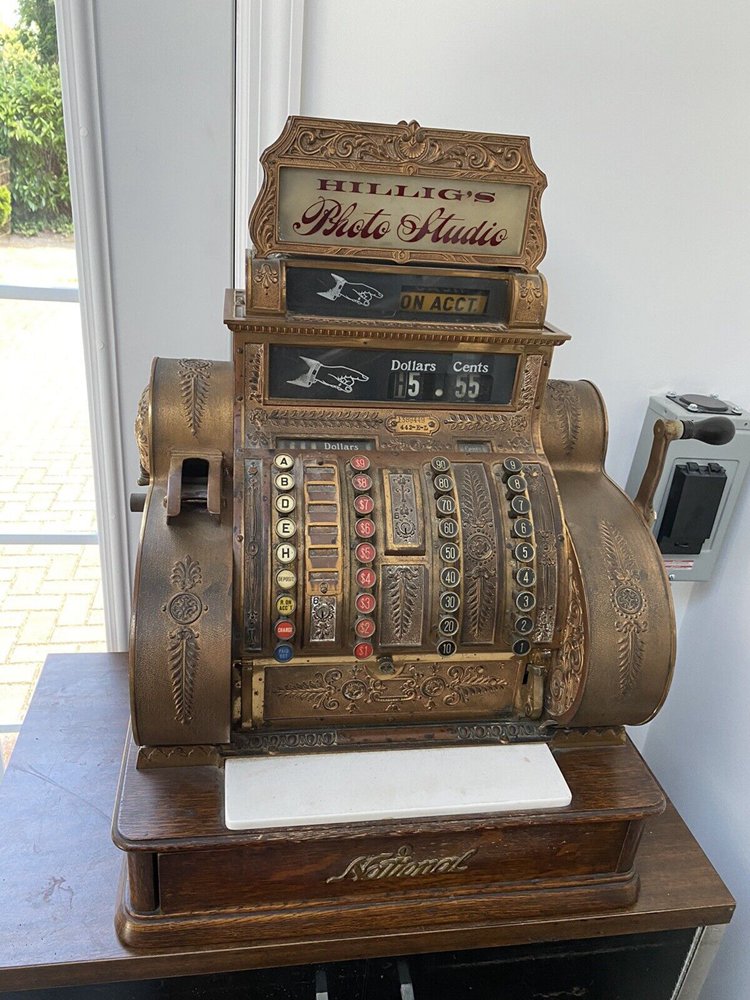
Brass national cash registers, as the name implies, are typically made of brass and have finishes such as polished brass, nickel plated brass, antiqued copper, and sometimes even silver and gold plates.
According to history, brass was the dominant manufacturing material at the time, especially in the National Cash Register Company.
Nickel-Plated Antique Cash Registers
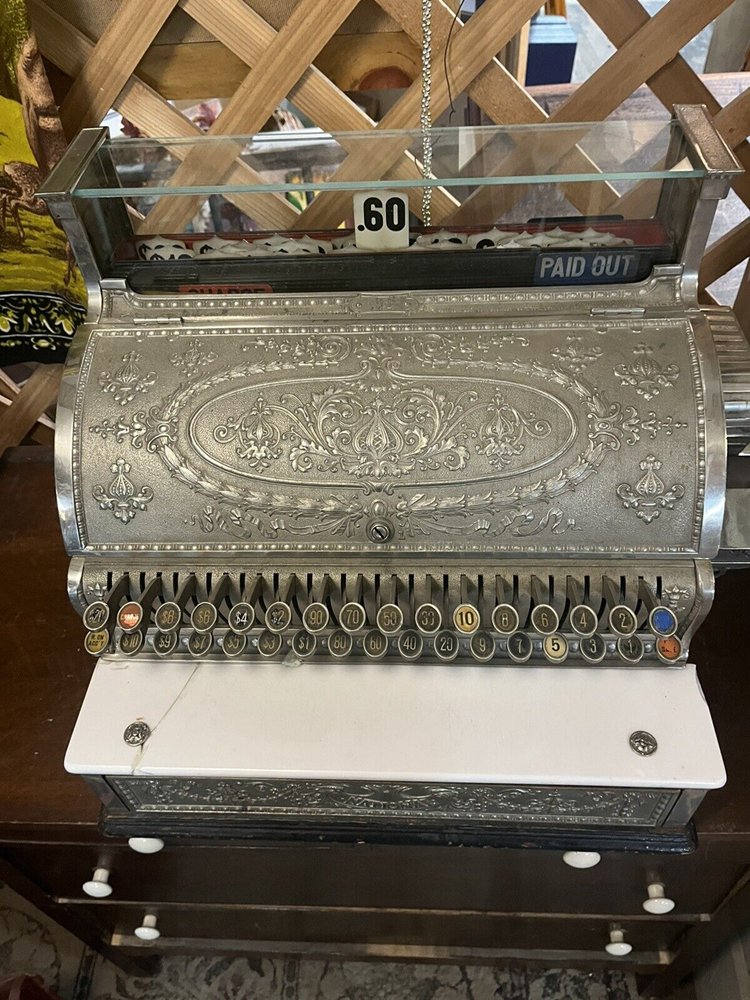
Nickel-plated antique cash registers can be crafted from iron or brass, and colored with silver or chrome. Nickel, on the other hand, does not rust or discolor, and as a result, it is possible to polish nickel using a compound such as Brasso.
Copper Oxidized Antique Cash Registers
Copper-oxidized-plated cash registers can be made from either brass or cast iron, and the finished product is usually copper with a black stain. When you’re done with the finishing process, the cash register will have an elegant look.
Determining the Value Of An Antique Cash Register
Do you sometimes find yourself wondering about the question “How much is my antique cash register worth?” Do you also want to know how much an old cash register on the market might be worth so you don’t get ripped off?
On online auction sites, the value of an antique cash register can range anywhere from a few thousand dollars to one hundred thousand dollars, but don’t be alarmed.
Whatever your budget, you’re bound to find an antique cash register that fits it. However, some factors must be considered in order to obtain perfect values. Among them are the following:
The Present Condition
The condition that the old cash register is in now has a direct bearing on how people will evaluate it as an antique. A cash register that is not fully functional or that is not in perfect working condition will not be as valuable as one that does function properly.
Determine the value of the cash register you are interested in buying or selling based on the condition it is in at the time of your inspection.
Features of the Cash Register
The features of a cash register, if intact, are likely to increase the value of your cash register. If, for example, the cash drawer is missing or damaged, it will be difficult to obtain a good price for it.
In the worst-case scenario, it will be sold as scrap. So, when determining the value of your cash register, consider the intact features.
The Age and Rarity of the Cash Register
As with many antiques, the older and rarer they are, the more valuable they are likely to be. Looking at the exterior design material of your cash register is an easy way to determine its age. If it is wood, you will know that it is one of the earliest cash registers.
If it’s made out of wood, it’s likely one of the earliest cash registers produced. A cash register made entirely of brass is likely from the second generation.
The combination of wood and brass indicates that it was manufactured after the introduction of brass. Such details provide insight into the cash register’s potential value.
The same is true for scarcity; the very first antique cash registers would be much more difficult to find than ones produced in the early 1900s, making it more valuable, especially if it is still intact.
The Market Demand
Look at what other people are charging for cash registers that are comparable to yours before you decide on a price.
When there are a large number of buyers who are desperate for an antique, sellers are forced to raise the price of the product. This invariably results in a change in the overall market price of the cash register.
Also, keep an eye out for the model that is currently selling the most as this will affect your final price.
Exterior Designs
When cash registers were first manufactured, the exterior designs were not heavily infused or engraved; they were mostly plain and without much design. However, as the cash register gained popularity and people needed to be drawn in, various exterior designs were used.
The exterior designs are likely to have an impact on how antique cash registers are viewed. Grand designs, such as designs with gold plating, could be listed at higher prices, primarily due to the fact that they are rarer and more appealing to the eye than other basic designs.
The Brand’s Worth
Antique national cash register models are usually in greater demand than other cash register models. This is largely due to the popularity of national cash register models at the time the antiques were manufactured.
It does not mean that other models cannot be expensive. In fact, brands that are not as well-known as national cash register models also have the potential to influence the valuations of antique cash registers, sometimes setting a very high value for the antiques.
Where to Get Collectible Cash Register Antiques
Yard sales and flea markets are excellent places for collectors to purchase antique cash registers, as well as for sellers to auction off their wares to interested buyers and collectors. You can also choose to sell them online, on eBay, Amazon, or Invaluable.
Etsy
Etsy is an online marketplace where you can buy a variety of goods. They also have antique cash registers for sale.
You must exercise caution, however, because almost everything sold on Etsy is created and marketed by the sellers themselves. As a result, it is prudent to only deal with verified sellers. You can also sell your antiques on the site.
eBay
eBay is another place you can buy and sell antiques online. Similar to Etsy, all products and services on this site are manufactured by the sellers.
It acts as an intermediary between buyers and sellers. You can purchase an antique cash register on eBay, but you should only do so from verified sellers to avoid being scammed.
Invaluable
Invaluable is one of the largest online auction markets in the world. You can buy, sell, and also participate in auctions and exhibitions on Invaluable.
As an artist, you can also sell your work. You have direct access to artists and their products on Invaluable, so you do not have to worry about stolen items.
Click the link above to register and view the available cash registers or to list one for auction.
Amazon
On Amazon, you can find any kind of antique cash register you are looking for. Even though you can always file a complaint with Amazon if you’ve made a poor purchase, you still need to be careful.
In addition, check to see that the cash register you intend to buy is in good condition, unless you specifically requested one that is not in perfect working order.
Frequently Asked Questions
1. How Much Is My National Brass Register Worth?
The value of brass national cash registers varies, but they can be worth up to $500. If you are interested in purchasing a brass national cash register, you should keep this price in mind.
2. What Does An Old Cash Register weigh?
An old cash register might weigh as much as 120 pounds. Antique cash registers are typically quite heavy, with brass registers being even heavier.
3. What Else Can You Call An Old Cash Register?
The British call an old cash register a “till.” The cash drawer of a register is also referred to as a till.
Conclusion
We hope that you are now able to accurately predict the values of your antique cash registers using the information that we have provided. Please leave a comment below if you have any additional questions or if you have any suggestions on antiques that we should work on next.






![Where To Sell Antique Furniture In 2022 [Ultimate Guide]](https://www.jacquelinestallone.com/wp-content/uploads/2022/09/Etsy-Your-Place-To-Buy-And-Sell-All-Things-Handmade-600x450.jpg)


